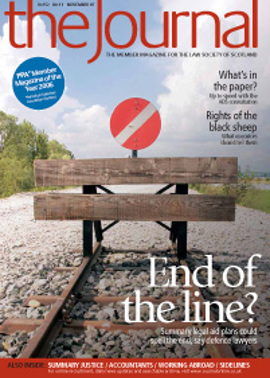The law and the forum

The recent Journal articles relating to family law have spurred me into print, in the hope we can continue dialogue with a view to promoting best practice amongst family lawyers, sheriffs, their clerks, Scottish Court Service and the Legal Aid Board. The more open and widespread the debate, the more likely we produce effective results.
I entirely agree with Liz Welsh’s view (Journal, August, 16) that “one size fits all” is not appropriate in family cases. While I also agree with Maggie Scanlan (Journal, July, 20) that there is not much “law” involved, I still think lawyers are best placed to help resolve these disputes. Any suggestion of removing family cases to some statutory body is frankly, scary: the Child Support Agency was chaotic, shambolic and often anathema to child welfare.
One of the many reasons it did not work was precisely because the family lawyer’s skills were ignored, since it was thought that the application of a formula would provide a “one size fits all” solution. I suspect that “Tesco law” will lead to more dumbing down and more problems in family disputes – but at least it’ll be dirt cheap and you’ll get Clubcard points!
With no apology for sounding crass, lawyers’ currency is language: we mould words in order to create understanding between individuals. This is particularly relevant in family cases, where emotions easily overtake reason – a recipe for misunderstanding, leading to polarised positions. Where children are involved, they are caught right in the middle.
Family litigation should be significantly different from other types in two respects: talking of “winners” and “losers” is not appropriate; and any understanding should be created between the parties, and not just (or even!) the judge. Indeed, I suggest that the more the judge is left out of the equation, the greater the prospect of a longer lasting resolution. I do not mean any disservice to judges, but sometimes the system is simply inadequate.
We need to refine the role of the courts and solicitors in issues involving children. The concept of child welfare hearings was an excellent step in the right direction. But what a divergence we have in how they are conducted, not least because hard-pressed sheriffs and clerks have to juggle a timetable almost entirely influenced by criminals who pick and choose when to take part in our judicial system. It’s a funny old world.
Given the pressures on civil work generally, it would be helpful to promote an attitude that shrieval intervention really is a last resort. This of course is an over-arching principle of the Children (Scotland) Act 1995, but it could be better refined. Collaborative family law is an excellent concept but goes further, I think, than we are ready for (certainly in my neck of the woods).
I believe all family lawyers should undergo training in mediation techniques. At the outset of a case, parents should be encouraged (compelled?) to participate in a joint meeting, with solicitors steering the discussion to identify the issues, identify what each side wants, explore solutions, and if nothing else, emphasise to parties in the strongest terms that the last resort should be placing their children’s lives into the hands of a sheriff under pressure of time and caseload.
I do not suggest we should examine why a relationship has broken down, but it can and should be our job to examine how that can be best managed.
It would be helpful to develop a “style” of child welfare hearings. I have known one sheriff address the parties as “you guys”, which sounds glib in print, but was very helpful in creating an atmosphere for dialogue rather than confrontation. Another sat alongside the parties, without gown or wig. The sheriffs in Dumbarton have the parties sit nearer the bench than the agents, and involve them as much as necessary.
Such techniques can be extremely helpful in creating an atmosphere which assists diametrically opposed parents concentrate on what is important and what is not. I would like to see more ideas in print, so we can exchange ways of conducting hearings.
In Glasgow, it is possible to email a particular sheriff, which failing the clerk’s office, at any stage, advising of agreement reached. No court attendance is necessary, leaving more time for contentious cases. I also suggest it would be helpful if, in difficult cases, agents set out an agenda and summary of the issues for the child welfare hearing, so the sheriff has some advance knowledge of the dispute as seen by both parties.
While this might at first glance appear to reduce our workload and potential fee income, it would encourage families to make more use of solicitors once it is realised that the system is actually designed to remove tension, rather than rack it up. However, none of this will take root unless those who provide the system are prepared to shift attitudes and explore new ways of dispensing justice. Now there’s a challenge if ever I heard one.
In this issue
- The shape of your future
- The law and the forum
- End of the line?
- Summary justice: the big picture
- Now it's your turn
- Flying south
- Legal rights and the black sheep
- Mediation innovation
- Counting on your CA
- The risk of paper cuts
- Society hits the Net at Murrayfield
- Leading the charge
- Computer says no
- Who, what, where, when, why?
- Getting in on the Act
- Scottish Solicitors' Discipline Tribunal
- Website reviews
- Book reviews
- Well funded work
- PSG offers an offer






